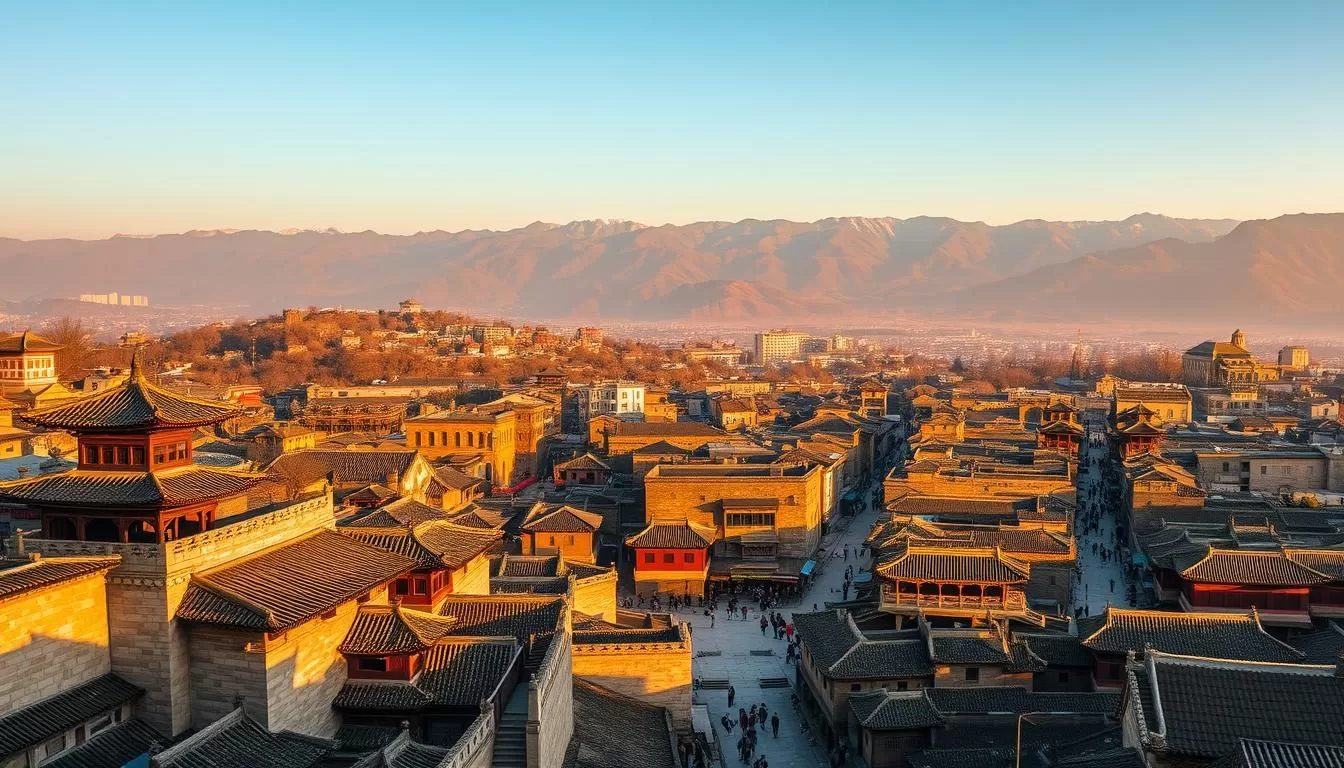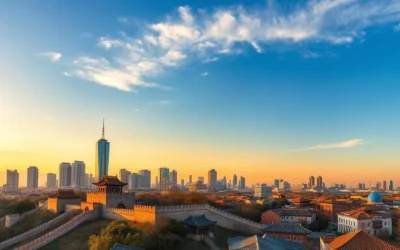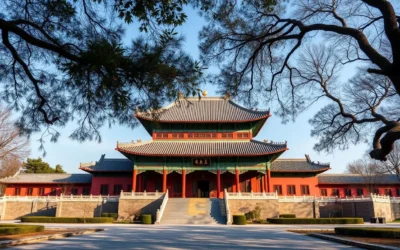✓ Accommodations✓ Flights✓ Rental Cars
Step into a region celebrated for its deep cultural roots and stunning historical landmarks. Known as a treasure trove of ancient architecture, this area offers a unique glimpse into the past. From towering structures reminiscent of the great wall to intricate designs that echo the forbidden city, every corner tells a story.
Explore UNESCO World Heritage Sites like the Pingyao Ancient City, where history comes alive. This well-preserved ancient city showcases the region’s architectural brilliance and cultural significance. Whether you’re a history enthusiast or a curious traveler, this destination promises an unforgettable journey through time.
Introduction to Shanxi Province & Its Rich Cultural Heritage
Discover a land where history and culture intertwine, offering a journey through time. Positioned west of Taihang Mountain with the Yellow River flowing through, this region is home to 452 national key cultural relics and well-preserved ancient buildings. Its reputation as a treasure trove of ancient architecture makes it a must-visit for history enthusiasts.
Diverse groups of travelers flock here to experience the authenticity and beauty of its sites. From UNESCO World Heritage Sites to intricate murals, every corner tells a story of the past. The Yungang Grottoes, one of the four major grottoes in the country, showcase the region’s artistic brilliance.
When planning your visit, understanding the historical price and value of tours is essential. Below is a comparison of average costs for popular destinations:
| Destination | Average Tour Price |
|---|---|
| Pingyao Ancient City | $120 |
| Yungang Grottoes | $90 |
| Mount Wutai | $150 |
Tourists typically spend an average of 4 days exploring two major destinations, such as Datong and Pingyao. For a more comprehensive experience, a combined trip covering Datong, Mount Wutai, Pingyao, and Taiyuan usually takes about 6 to 7 days.
This region’s cultural richness rivals other well-known areas, offering a unique blend of history and natural beauty. Whether you’re marveling at ancient structures or soaking in the spiritual energy of sacred sites, your journey here will be unforgettable.
Ancient Architectural Marvels of Shanxi
Uncover the timeless beauty of ancient structures that have stood the test of time. This region is a treasure trove of architectural wonders, where every stone tells a story of craftsmanship and history. From towering walls to intricate temples, these sites are a testament to human ingenuity.
UNESCO World Cultural Heritage Sites
Explore the incredible UNESCO-listed sites that showcase the region’s rich heritage. The Yungang Grottoes, carved over centuries, feature 252 caves and over 51,000 sculptures, making them a masterpiece of Buddhist art. Another gem is the Pingyao Ancient City, with its 6,163-meter-long walls and over 2,700 years of history.
These sites are not just relics of the past but living examples of cultural preservation. Walking through them, you’ll feel a deep connection to the traditions and artistry that shaped this land.
Iconic Ancient City Walls and Structures
The ancient walls here are more than just fortifications; they are symbols of resilience. The walls of Pingyao, for instance, have protected the city for centuries and remain remarkably intact. They offer a glimpse into the daily lives of those who lived within their embrace.
Beyond the walls, you’ll find temple complexes and courtyards that highlight the region’s architectural brilliance. These structures have endured for generations, serving as both functional spaces and artistic masterpieces.
Whether you’re marveling at the grandeur of a temple or tracing the curves of a city wall, these ancient marvels will leave you in awe of their enduring legacy.
Shanxi Province, China: Best Things to Do – Top Picks
Immerse yourself in a land where history unfolds at every turn, offering year-round adventures. This region is a treasure trove of cultural wonders, from ancient palace-like structures to vibrant museums of art. Whether you’re a first-time visitor or a seasoned traveler, there’s always something new to discover.
Start your journey with the UNESCO-listed sites that highlight the area’s rich heritage. The Yungang Grottoes, with over 5,100 sculptures, are a testament to artistic brilliance. These sites are not just relics of the past but living examples of cultural preservation.
For a deeper dive into history, explore the ancient city walls and courtyards. These structures have stood for centuries, offering a glimpse into the lives of those who built them. Each site tells a unique story, making them must-visit spots for any tourist.
Planning your trip? Consider combining visits to multiple landmarks for a comprehensive experience. Most travelers spend about 4 days exploring two major destinations, while a 6-day tour covers even more. This approach ensures you don’t miss any highlights.
From the spiritual energy of sacred temples to the grandeur of ancient architecture, this region promises an unforgettable journey. Make the most of your visit by integrating these iconic sites into your travel plan.
Discover Pingyao Ancient City: A Living Museum
Step into a living museum where history breathes through ancient streets and towering walls. This UNESCO World Cultural Heritage site is a treasure trove of Ming and Qing Dynasty relics, offering a unique glimpse into China’s past.
Historical Significance & City Walls
Pingyao’s 6,163-meter-long city walls have stood for over 2,700 years, making them one of the best-preserved defensive structures in the world. Known as the “Turtle City,” its layout symbolizes longevity and protection, with six gates strategically placed for defense.
Inside the walls, you’ll find ancient streets, temples, and courtyards that reflect urban planning from 1368 to 1911. These structures tell stories of a time when Pingyao was the financial hub of China, home to the first bank, Rishengchang Exchange Shop.
Essential Experiences for History Lovers
Plan your visit to make the most of your time. Tickets cost CNY125, and you can explore the city in as little as half a day or spend a full day immersing yourself in its history. Walking through the city is the only way to experience its charm, as cars are not allowed within the walls.
Don’t miss the Pingyao Confucian Temple, the Ancient Government Office, and Shuanglin Temple, each offering a unique perspective on the city’s rich heritage. For a deeper connection, consider the nearby influence of the Yellow River, which adds to the region’s scenic beauty.
Whether you’re marveling at the intricate architecture or tracing the footsteps of ancient merchants, Pingyao Ancient City promises an unforgettable journey through time.
Awe-Inspiring Yungang Grottoes
Discover a masterpiece of Buddhist art carved into the heart of a mountain. The Yungang Grottoes, a UNESCO World Heritage site, is a place where history and spirituality come alive. With 252 caves and over 51,000 sculptures, this site is a testament to ancient craftsmanship and devotion.
Buddhist Art & Exquisite Sculptures
Every person who visits the Yungang Grottoes is captivated by the intricate statues. These sculptures, carved between 460 AD and 524 AD, represent key aspects of Buddhist culture. From towering bodhisattvas to detailed depictions of Shakyamuni Buddha’s life, the artistry is breathtaking.
One of the highlights is Cave 5, home to the tallest Buddha statue in the complex. Cave 6 is equally impressive, featuring early examples of religious comics. These masterpieces are not just art; they are windows into the spiritual beliefs of ancient times.
Exploring the Cave Complex
Exploring this place is an unforgettable experience. The grotto complex stretches for 1 kilometer, with 40 caves currently open to the public. Each cave offers a unique glimpse into the past, making it a must-visit for history and art enthusiasts.
Here are some practical tips for your visit:
- Plan for 2 to 3 hours to fully appreciate the site.
- Visit during off-peak season (November 1st – March 31st) for lower ticket prices.
- Wear comfortable shoes, as the terrain can be uneven.
Whether you’re marveling at the artistry or soaking in the spiritual energy, the Yungang Grottoes is a place that will leave you in awe.
Marvel at Hengshan Hanging Temple
Experience the awe-inspiring Hengshan Hanging Temple, a marvel of ancient engineering and spiritual harmony. Perched on a cliff over 1,500 years ago, this world cultural treasure defies conventional architecture. It’s a testament to the ingenuity of ancient builders and a symbol of unity among Buddhist, Taoist, and Confucian traditions.

Unique Cliffside Architecture
The temple’s design is a masterpiece of ancient building techniques. Supported by 30 wooden pillars and hidden beams, it clings to the cliffside, with its highest point reaching 90 meters above the ground. The structure spans 32 meters and includes 40 pavilions and halls, each with intricate details that reflect centuries of history.
Inside, you’ll find over 80 statues made of bronze, iron, clay, and stone, showcasing the artistic brilliance of its creators. The temple’s unique location ensures it receives only three hours of sunlight daily, adding to its mystical aura.
Tips for a Safe and Enjoyable Visit
Planning your visit? The temple is open from 7:30 AM to 6:30 PM from March to October and 8:30 AM to 5:00 PM from November to February. The entrance fee is 15 yuan, with an additional 100 yuan climbing fee. Allow at least two hours to fully appreciate this world cultural gem.
For the best experience, visit during spring or fall when the weather is mild. Wear comfortable shoes, as the terrain can be uneven. If you’re traveling from Datong, the journey takes about 1.5 hours by bus.
This building is not just an architectural wonder but a journey through history. Its fusion of nature and spirituality makes it a must-see for anyone seeking a deeper connection to the past.
Experience the Spiritual Energy of Mount Wutai
Feel the spiritual energy of a sacred mountain where history and nature converge. Mount Wutai is one of the four sacred Buddhist mountains, offering a unique blend of cultural richness and natural beauty. With 47 temples and extensive pilgrimage routes, this attraction is a magnet for spiritual seekers and nature lovers alike.
Sacred Temples and Pilgrimage Routes
Mount Wutai is home to some of the most revered temples in the region. Xiantong Temple, the largest and oldest, features a Bronze Hall made of 50,000 kg of bronze. Another highlight is Shuxiang Temple, which houses the largest statue of Manjusri Bodhisattva, standing nearly 10 meters tall.
Pilgrimage routes here are not just spiritual journeys but also cultural experiences. Walking these paths, you’ll connect with centuries-old traditions and witness the devotion of countless pilgrims.
Scenic Hiking and Natural Beauty
For nature enthusiasts, Mount Wutai offers stunning hiking trails. The mountain’s five flat peaks provide panoramic views of lush valleys and serene landscapes. Whether you’re an experienced hiker or a casual walker, the trails cater to all levels of fitness.
Here’s a quick guide to planning your visit:
| Activity | Duration |
|---|---|
| Temple Exploration | 2-3 hours |
| Hiking Trails | 3-4 hours |
| Pilgrimage Routes | Full day |
Mount Wutai is more than just a destination; it’s an experience that enriches your understanding of Buddhist traditions and mountain landscapes. Plan your visit to this remarkable attraction and discover its profound spiritual and natural wonders.
Explore the Wealthy Legacies at Wang’s Family Compound
Step into a sprawling historic estate that tells the story of wealth and tradition. Wang’s Family Compound is a remarkable site that showcases the grandeur of ancient courtyard residences. With 35 interconnected courtyards, it’s a living testament to the opulence of local families.
Intricate Courtyard Residences
As you wander through the compound, you’ll notice the intricate designs of each courtyard. The layout reflects traditional Chinese architecture, with detailed carvings and decorations that highlight the craftsmanship of the era. This site is a treasure trove of architectural beauty, offering a glimpse into the lives of the wealthy elite.
Comparisons to western influences in ancient architecture add an interesting layer to your visit. The blend of styles reveals how cultural exchanges shaped the region’s design aesthetics. Each corner of the compound tells a story, making it a must-see for history enthusiasts.
Cultural and Historical Insights
The compound’s rich history reflects the cultural practices of its time. Families here were known for their wealth and influence, and the estate served as a hub for social and economic activities. Exploring this site gives you a deeper understanding of the region’s heritage.
Here are some tips to make the most of your visit:
- Take your time to explore each courtyard—there’s a lot to discover.
- Hire a guide to gain insights into the architectural features and historical significance.
- Visit during off-peak hours to enjoy a quieter experience.
Wang’s Family Compound is more than just a historic site; it’s a journey through time. Whether you’re marveling at the architecture or learning about the families who lived here, this estate offers a lot of cultural and historical insights.
Step Inside Qiao’s Family Compound
Step into a historic compound where traditional architecture meets cinematic fame. Qiao’s Family Compound, established in 1756, is a stunning example of northern Chinese folk architecture. Its intricate design and cultural significance make it a must-visit for anyone with an interest in history and film.
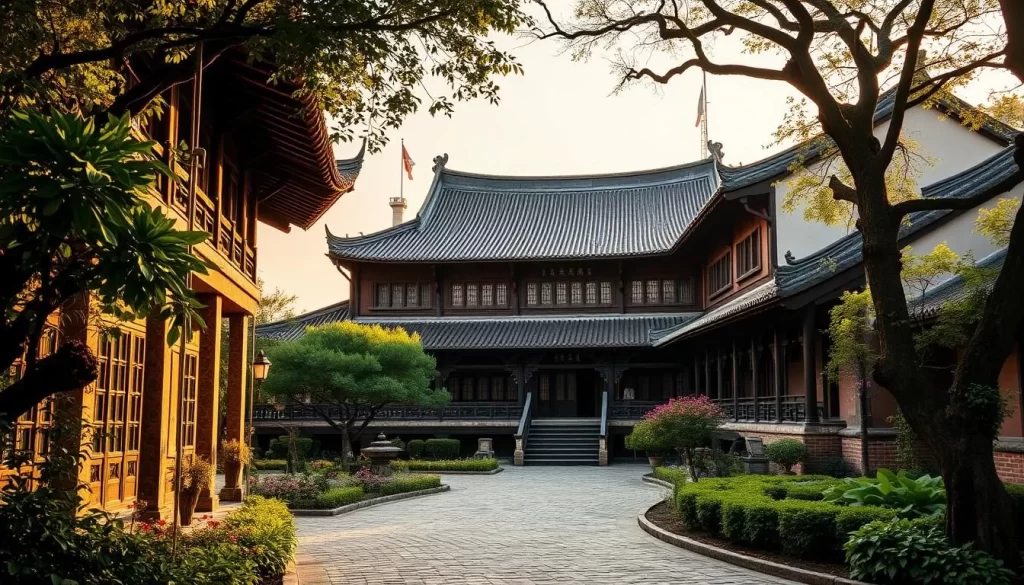
Traditional Folk Architecture & Film Connection
This compound spans 8,700 square meters and features 6 large courtyards and 20 smaller ones, totaling 313 rooms. Each part of the compound showcases detailed carvings and traditional layouts, reflecting the wealth and discipline of the Qiao family. Their influence extended nationwide, with over 200 shops and businesses.
The compound gained international fame as the filming location for Zhang Yimou’s Raise the Red Lantern. This connection adds a layer of cinematic allure to its already rich history. Walking through its courtyards, you’ll feel like you’ve stepped into a scene from the film.
Here’s a list of highlights to explore:
- Intricate interior courtyards and room layouts
- Historical artifacts that tell the family’s story
- Architectural details that blend functionality and artistry
Practical visitor insights include ticket prices ranging from 40 to 80 yuan, depending on the season. Plan for a half-day visit to fully appreciate every part of this remarkable site. For more on the preservation of such architectural gems, check out this detailed study.
Qiao’s Family Compound is more than just a historic site; it’s a journey through time and culture. Whether you’re drawn by its architecture or its cinematic legacy, this place will captivate your interest and leave you with lasting memories.
Witness the Power of Hukou Waterfall
Witness the raw power of nature at Hukou Waterfall, a stunning natural wonder that captivates every visitor. Known as the world’s largest yellow waterfall, it’s a sight that leaves you in awe of its sheer force and beauty. The water cascades with such intensity, ranging from 800 to 1,200 cubic meters per second, creating a spectacle that’s both mesmerizing and humbling.
Best Viewing Times and Scenic Spots
To fully appreciate this natural marvel, plan your visit between May and October. During these months, the water flow is at its peak, offering the most dramatic views. The mist rising from the falls creates a magical atmosphere, perfect for photography and nature observations.
For the best sightseeing experience, head to the scenic spots that frame the waterfall. These vantage points provide panoramic views of the cascading water and the surrounding landscape. Whether you’re an avid photographer or simply a nature lover, these spots will leave you spellbound.
Here’s a quick guide to enhance your visit:
- Visit during early morning or late afternoon for optimal lighting.
- Wear comfortable shoes, as the terrain can be uneven.
- Bring a waterproof jacket to stay dry from the mist.
Hukou Waterfall isn’t just a sight to behold; it’s an experience that connects you with the raw energy of nature. Its grandeur resonates deeply, making it a must-visit for anyone exploring the region. For more travel inspiration, check out this Silk Road travel guide.
Journey Through History at Jinci Temple
Embark on a historical exploration at Jinci Temple, where centuries of culture and craftsmanship converge. Located 25 km southwest of Taiyuan, this site offers a living museum experience that spans multiple dynasties. From the Tang to the Qing, each era has left its mark, creating a unique blend of styles and stories.
As you walk through the temple grounds, you’ll notice the intricate details of its architecture. Pavilions, ancestral halls, and gardens showcase the evolution of design over centuries. This place is not just a temple; it’s a testament to the region’s rich cultural heritage.
Architectural Gems and Cultural Layers
Jinci Temple’s architecture is a highlight for any visitor. The Hall of the Holy Mother, built during the Song Dynasty, is a masterpiece of wooden construction. Its detailed carvings and vibrant colors offer a stunning view of ancient craftsmanship.
Another must-see is the Flying Bridge, a rare example of Song Dynasty engineering. Its unique design and historical significance make it a favorite among history enthusiasts. Every corner of the temple tells a story, making it an immersive experience.
Here’s what you need to know before your visit:
- Ticket prices: ¥80 per person
- Recommended duration: 2-3 hours
- Best time to visit: May to October for pleasant weather
Jinci Temple is more than just a destination; it’s a journey through time. Whether you’re marveling at its architecture or soaking in its cultural layers, this site offers a view into the past that’s both educational and inspiring. For a deeper dive into the region’s heritage, consider this 11-day tour exploring significant cultural sites.
Discover the Fortified Past at Yanmen Pass
Step back in time at Yanmen Pass, where history and defense strategies come alive. This ancient fortress, part of the Great Wall, played a critical role in protecting the heartland for centuries. Today, it stands as a remarkable relic of military ingenuity and architectural brilliance.

Military History and Defensive Architecture
Yanmen Pass is a treasure trove of military history. Its strategic location made it a key defensive area during the Ming and Qing dynasties. The pass features ancient siege walls, watchtowers, and gates that showcase the advanced engineering of its time.
As you explore, you’ll encounter surviving structures that highlight its importance. These relics tell stories of battles fought and victories won. The pass’s design reflects the tactical genius of ancient strategists, making it a must-visit for history enthusiasts.
Planning your visit? A private day trip to Yanmen Pass offers a comprehensive experience. You’ll hike along the historic Great Wall and explore the pass’s key landmarks with an English-speaking guide.
Here’s what you need to know:
- Allow at least half a day to fully explore the area.
- Wear comfortable shoes, as the terrain can be uneven.
- Visit during spring or fall for pleasant weather and fewer crowds.
Yanmen Pass is more than just a historic site; it’s a journey through the military strategies that shaped the region. Whether you’re marveling at its architecture or learning about its role in history, this fortress offers a unique glimpse into the past.
Uncover the Legends of Mount Mian
Dive into the rich tapestry of legends and natural beauty at Mount Mian, a place where history and folklore intertwine. This mountain is not just a scenic wonder but also a cultural landmark that has shaped local traditions for centuries. From its ties to the Cold Food Festival to its breathtaking views, Mount Mian offers a unique experience for every traveler.
Origins of the Cold Food Festival
Mount Mian is celebrated as the birthplace of the Cold Food Festival, a tradition rooted in the story of Jie Zitui. This folk tale tells of loyalty and sacrifice, making the mountain a symbol of cultural heritage. The festival, observed by avoiding fire and eating cold food, is a testament to the enduring influence of these ancient stories.
As you explore the mountain, you’ll encounter sites that bring these legends to life. These locations offer a deeper connection to the region’s history and the values it cherishes. For any traveler, this is a chance to step into a narrative that has been passed down through generations.
Breathtaking Natural Views
Beyond its cultural significance, Mount Mian is a haven for nature lovers. The mountain’s trails lead to panoramic views that showcase the beauty of the natural world. Whether you’re hiking to its peaks or simply soaking in the scenery, the experience is nothing short of awe-inspiring.
Here are some tips to make the most of your visit:
- Plan your trip during spring or fall for the best weather conditions.
- Wear comfortable shoes, as the terrain can be uneven.
- Take your time to explore the trails and enjoy the views.
Mount Mian is more than just a destination; it’s a journey through history, culture, and nature. Whether you’re drawn by its legends or its landscapes, this mountain promises an unforgettable experience for every traveler.
More Must-Visit Attractions in Shanxi
Venture beyond the well-trodden paths and uncover the hidden gems that complete the mosaic of this culturally rich region. While the famous landmarks draw crowds, the lesser-known spots like Taihang Mountain Grand Canyon and Yuncheng Salt Lake offer a different way to explore. These natural wonders combine adventure with cultural discovery, making them essential stops on your journey.
Exploring Taihang Mountain Grand Canyon
Taihang Mountain Grand Canyon is a breathtaking destination that showcases the raw beauty of nature. Known for its dramatic cliffs and lush valleys, it’s a perfect spot for hiking and photography. The canyon’s trails wind through scenic landscapes, offering panoramic views that will leave you in awe.
For the best way to experience the canyon, plan your visit during spring or fall. The weather is mild, and the scenery is at its peak. Whether you’re an experienced hiker or a casual walker, the trails cater to all levels of fitness. Don’t forget to bring comfortable shoes and a camera to capture the stunning views.
Discovering Yuncheng Salt Lake
Yuncheng Salt Lake is another must-visit attraction that offers a unique experience. Known as the “Dead Sea of China,” this natural wonder is famous for its therapeutic properties and vibrant colors. The lake’s mineral-rich waters attract visitors looking for relaxation and rejuvenation.
Boat tours are a popular way to explore the lake, allowing you to soak in its beauty from the water. The nearby Buddhist mountain adds a spiritual dimension to your visit, making it a perfect blend of nature and culture. Plan your trip during the early morning or late afternoon for the best lighting and fewer crowds.
These attractions are more than just scenic spots; they’re gateways to a deeper connection with nature and history. For more inspiration, check out the real-life locations of Black Myth: Wukong, which have recently gained popularity among travelers.
How to Craft Your Perfect Shanxi Itinerary
Plan your journey with ease by crafting a personalized itinerary that covers the highlights of this culturally rich region. Whether you’re exploring ancient city walls or savoring local delicacies, a well-structured plan ensures you don’t miss a thing.
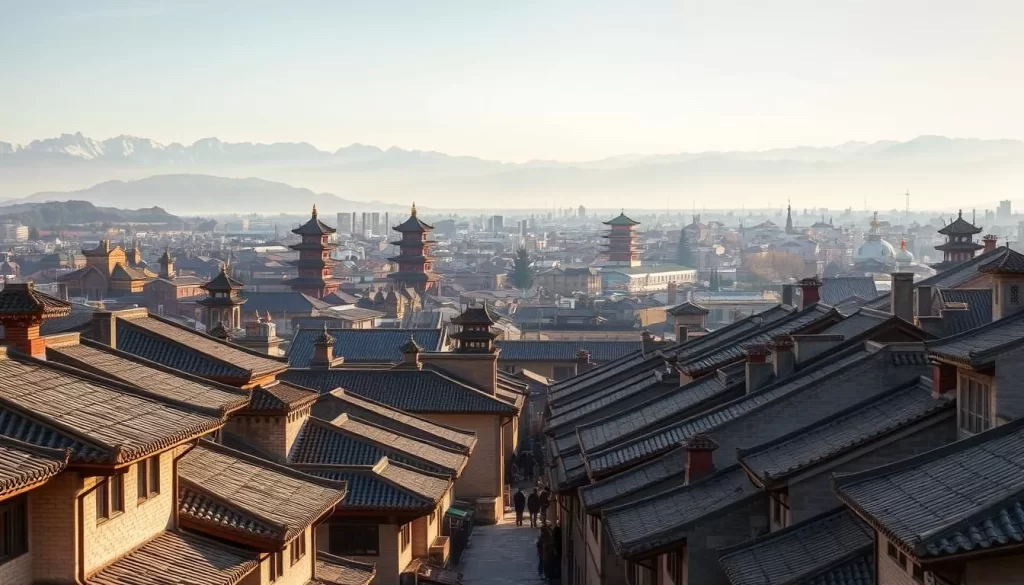
Travel Tips, Duration, and Ticket Information
Start by deciding how many days you’ll spend in the area. Most travelers allocate four days to explore two major destinations, while a six to seven-day trip allows for a more comprehensive experience. For example, combining visits to Datong, Pingyao, Mount Wutai, and Taiyuan offers a balanced mix of history and nature.
Here’s a quick guide to help you plan:
- Duration: Spend at least half a day at Pingyao Ancient City and Yungang Grottoes.
- Tickets: Pingyao Ancient City costs 125 yuan, while Yungang Grottoes is 90 yuan.
- Transportation: Use trains or buses for efficient travel between cities.
Local Cuisine and Cultural Highlights
No trip is complete without indulging in the local flavors. Try Pingyao beef, a tender delicacy best enjoyed at Guanyun Beef Restaurant. Pair it with Wantuo, a buckwheat-based snack, or Kaolaolao, a noodle dish served with mutton soup.
Cultural experiences are equally enriching. Walk along the ancient city walls of Pingyao, which stretch over 6,163 meters and offer a glimpse into the region’s history. Don’t miss the Yungang Grottoes, home to over 51,000 sculptures carved between 460 AD and 524 AD.
By balancing visits to historic sites with culinary adventures, you’ll create a memorable journey through this vibrant region. Whether you’re a history buff or a foodie, your itinerary will reflect the unique charm of city shanxi.
Conclusion
From ancient wonders to breathtaking landscapes, this region offers a journey through time and nature. Whether you’re marveling at the intricate designs of ancient temples or soaking in the beauty of its natural scenery, every moment here is unforgettable.
This destination is a treasure trove of cultural heritage and natural beauty. From the towering walls of ancient cities to the serene trails of sacred mountains, there’s something for every traveler. Each site tells a story, inviting you to explore and connect with the past.
Ready to embark on your own adventure? Plan your visit and experience the magic of this remarkable region. Whether you’re drawn by its history or its landscapes, your journey will be filled with discovery and wonder. Don’t miss iconic spots like the Mutianyu Great Wall, a perfect blend of history and scenic beauty.
The above is subject to change.
Check back often to TRAVEL.COM for the latest travel tips and deals.
